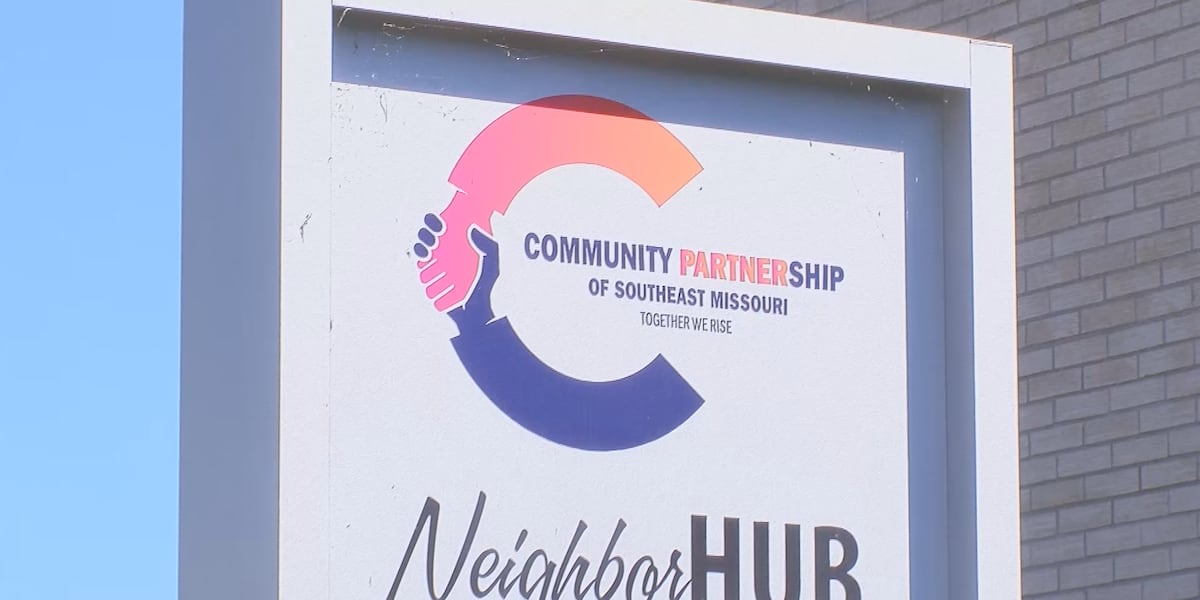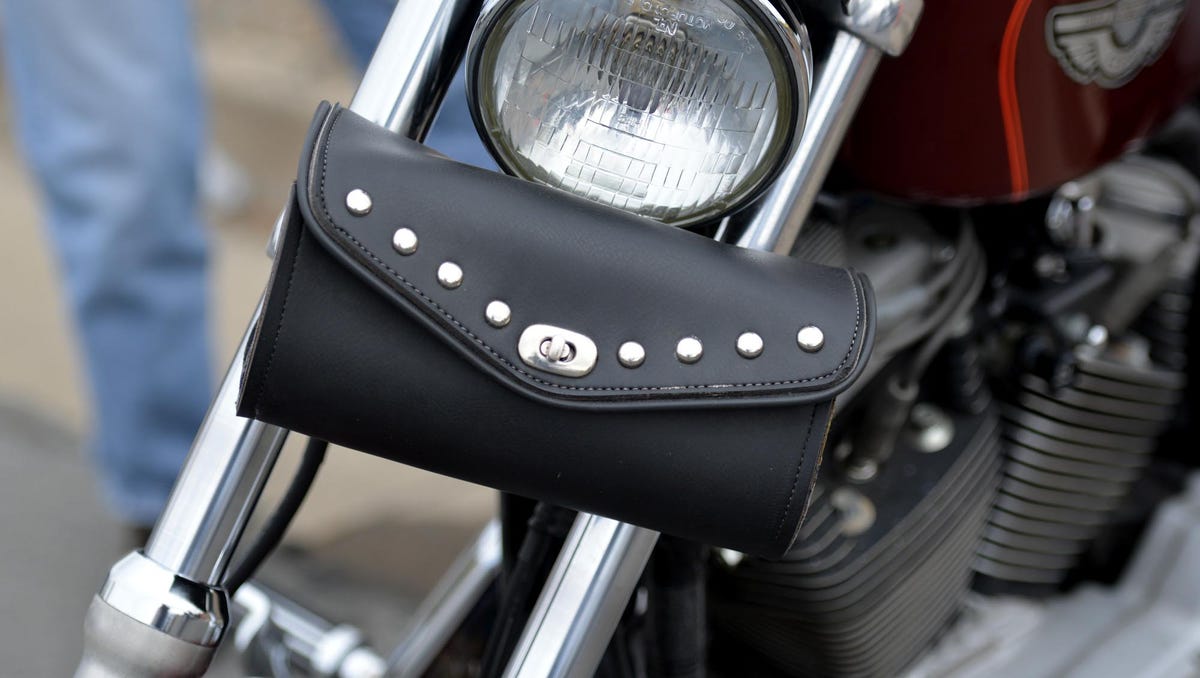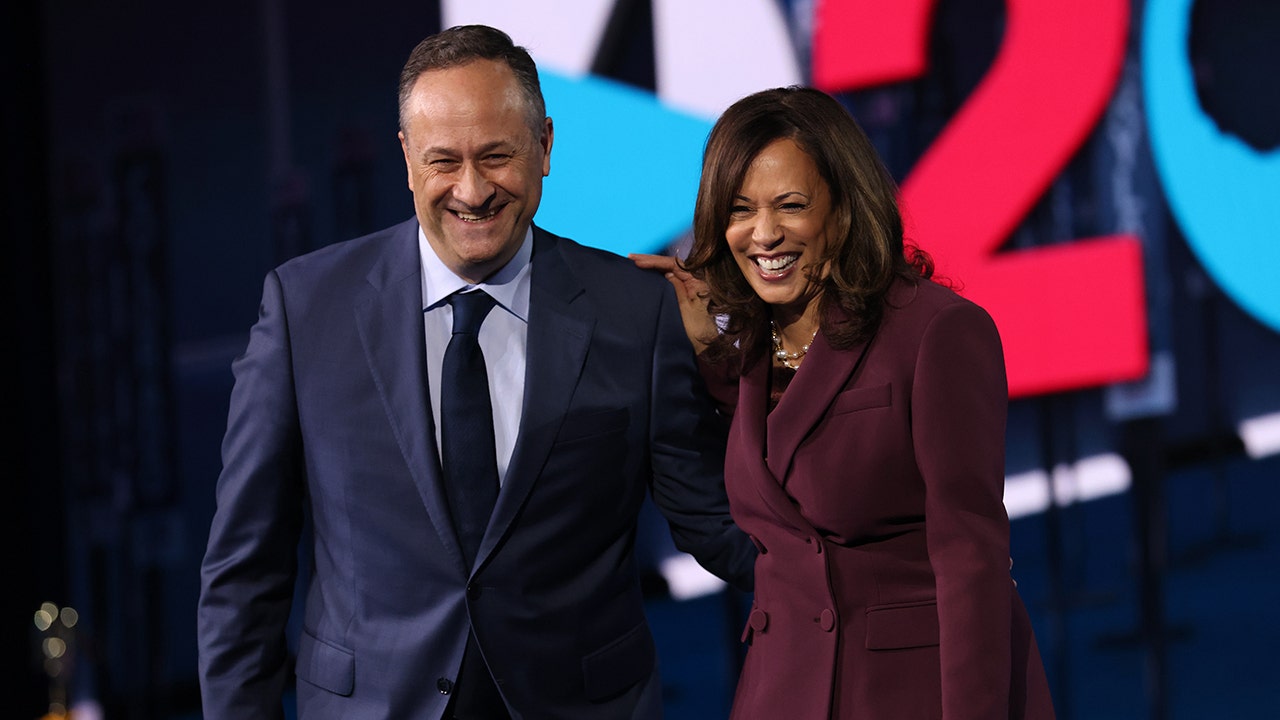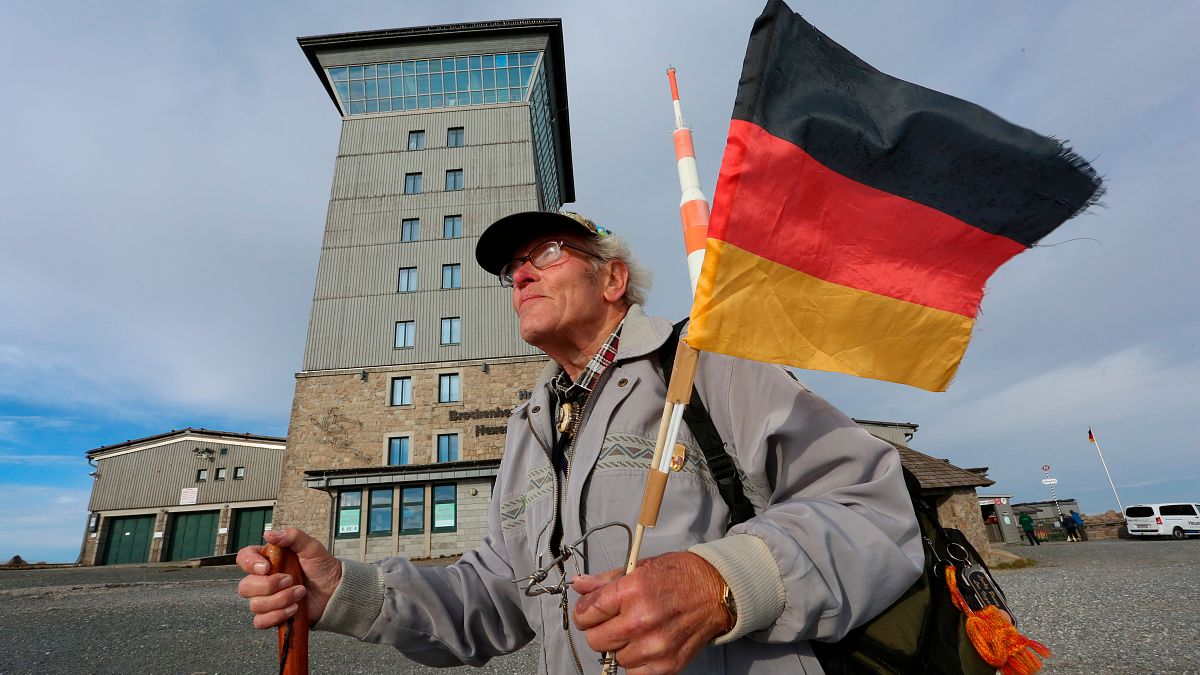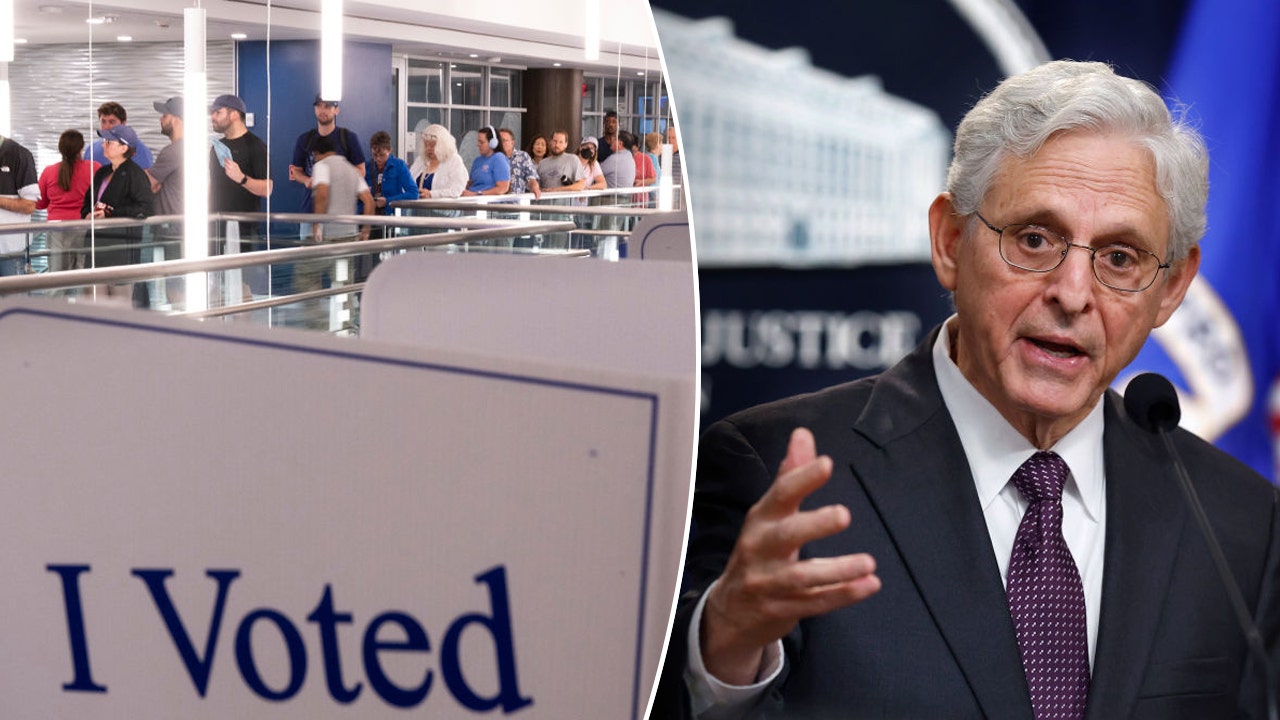Sports
Virginia Tech coach Brent Pry rips referees over Hail Mary touchdown reversal: 'Don't see how you overturn it'
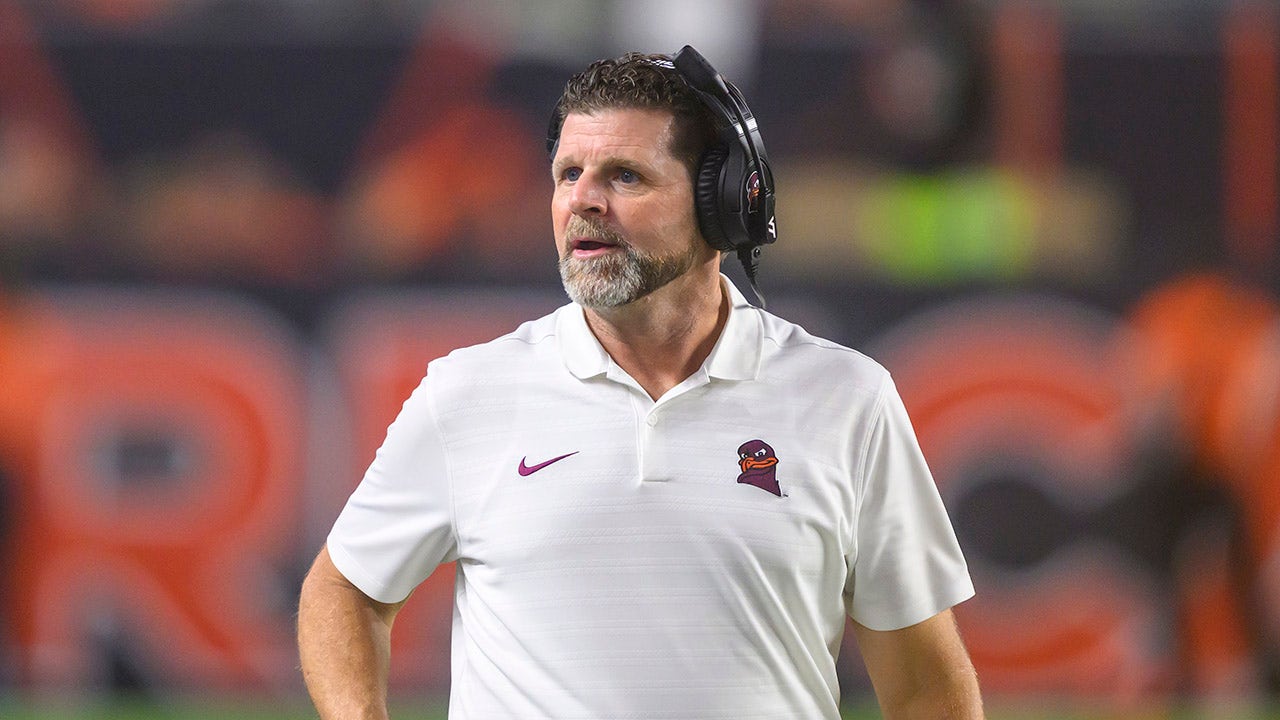
The Atlantic Coast Conference has been under fire in the days after the controversial ending of a game between two conference foes.
The Miami Hurricanes and Virginia Tech Hokies took turns celebrating what each team believed at the time was a victory.
But college football games can only have one winner.
A chaotic final play resulted in heartbreak for Virginia Tech when referees overturned a Hail Mary touchdown that allowed Miami to survive. This week, Virginia Tech coach Brent Pry became the latest critic of the ACC.
Virginia Tech head coach Brent Pry walks the sideline during a game against the University of Miami Hurricanes Sept. 27, 2024, at Hard Rock Stadium in Miami Gardens, Fla. (Doug Murray/Icon Sportswire via Getty Images)
Pry argued game officials failed to provide an explanation in the moments after their call or in the locker room after Friday’s game. The coach revealed he did not receive an explanation about the reversal until the ACC released what he described as a “confusing, at best” statement early Saturday morning.
VIRGINIA TECH PLAYER BLASTS ACC AFTER REVERSED WALK-OFF HAIL MARY: ‘I WANNA SEE CONSEQUENCES’
“I was finally contacted Monday morning, which was a solicited contact, by the head of officials for the ACC,” Pry said Tuesday.
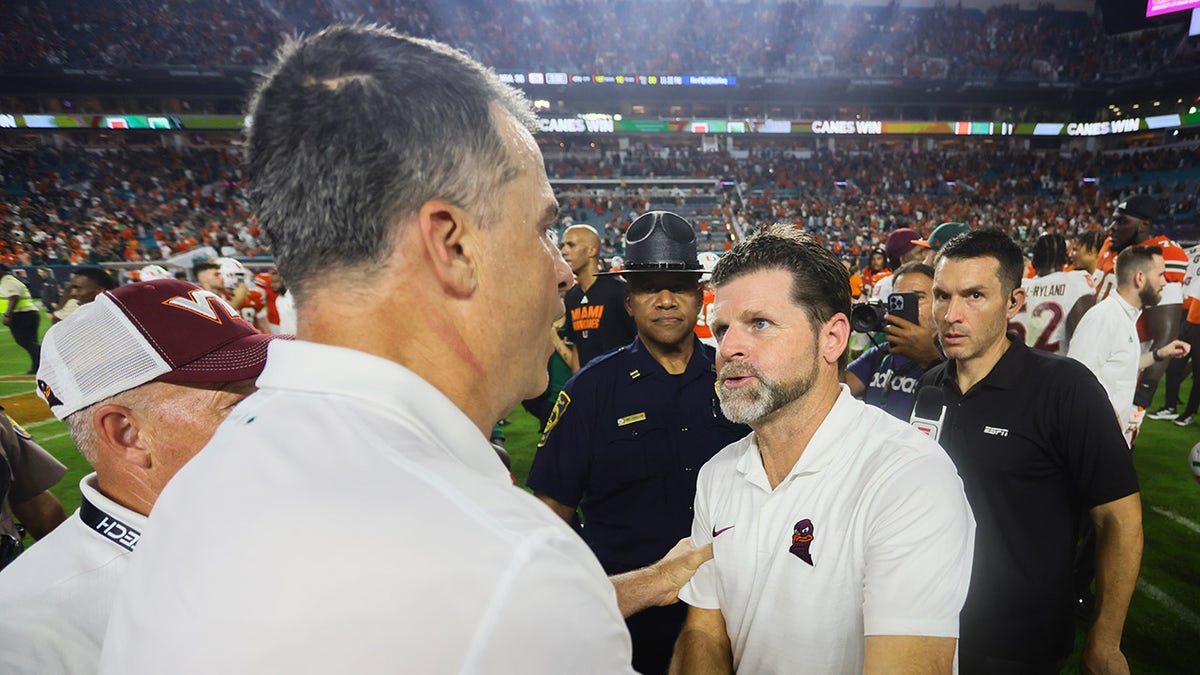
Virginia Tech Hokies head coach Brent Pry shakes hands with Miami Hurricanes head coach Mario Cristobal after a game at Hard Rock Stadium in Miami Gardens, Fla., Sept. 27, 2024. (Sam Navarro/Imagn Images)
“I asked for an explanation and the video that they viewed that merited overturning the call with indisputable evidence. The explanation was that there was a loose ball that was touched by a Miami defender who was out of bounds. The video showed nothing new, nothing that none of us hadn’t seen already. The words used with me were ‘interpretation’ and ‘hard to find,’ which, to me, neither one aligns with indisputable.”
Pry also asserted that there was an insufficient amount of evidence to support the decision to overturn the initial call.
“I watched the video that they watched. If it was ruled a catch, I don’t see how you overturn it. There’s no evidence. If it was ruled not a catch, I don’t see how you overturn it. You can’t see enough to tell.”
The league “determined that the loose ball was touched by a Miami player while he was out of bounds.”
“During the review process of the last play of the Virginia Tech at Miami game, it was determined that the loose ball was touched by a Miami player while he was out of bounds, which makes it an incomplete pass and immediately ends the play,” the statement from the ACC said.
Virginia Tech quarterback Kyron Drones threw the ball to receiver Da’Quan Felton as the final seconds ticked off the clock during the game Sept. 27. Felton appeared to complete the catch, but the referees later ruled the pass incomplete.

Virginia Tech wide receiver DaQuan Felton (9) catches the ball in the end zone against Miami defensive back Tyler Rowe (43) and Miami defensive back Mishael Powell (0). The initial game-winning touchdown call was overturned and ruled an incomplete pass during a game between Virginia Tech and Miami Sept. 27, 2024, in Miami Gardens, Fla. (Doug Murray/Icon Sportswire via Getty Images)
Virginia Tech will look to rebound this weekend when it travels to California for a matchup with Stanford. Miami will also be in the Golden State Saturday for a game against the California Golden Bears.
Miami enters Week 6 with a 5-0 record and climbed the No. 8 spot in the latest AP Top 25 rankings.
Follow Fox News Digital’s sports coverage on X, and subscribe to the Fox News Sports Huddle newsletter.

Sports
How Daniel Ricciardo became a new kind of F1 star

Stay informed on all the biggest stories in Formula 1. Sign up here to receive the Prime Tire newsletter in your inbox every Monday and Friday.
The shoeys. The jokes. The tattoos. The infamous, exaggerated “Pierreee Gaslyyyyyy!!!” and Nico Hülkenberg shouts.
Daniel Ricciardo isn’t a world champion or among the Formula One all-time greats based on his results — eight wins, three pole positions and 32 podium finishes over 13 seasons. But in the sport’s modern era, the Australian driver cemented himself as a one-of-a-kind icon by wearing his heart on his sleeve. The authenticity and humanity Ricciardo brought over the years drew in fans, new and old.
The Ricciardo glimpses over six seasons of Netflix’s ‘Drive to Survive’ docuseries is the same driver media saw in the paddock. But beneath the surface is a fierce competitor. His peak came during his Red Bull days, from 2014-2018, and his last time on the podium happened in 2021 when he won the Italian Grand Prix, McLaren’s first F1 win since 2012.
“For anyone who thought I left, I never left,” he said over the team radio that day. “Just moved aside for a while.”
But he also experienced two hiatuses, one when he departed McLaren in 2022 and again in 2023 as he recovered from surgery while competing for AlphaTauri (now known as RB). His speed is evident, but Ricciardo lacked consistency in 2024. Questions arose whether Ricciardo could make a comeback to the senior team — a goal that never came to fruition.
“This year, the purpose was to try and do good enough to get back into Red Bull and fight for wins again, see if I’ve still got it,” Ricciardo said in Singapore. “I felt like I came up short with that, so I think it’s then, ‘OK, what else am I fighting for here? What else is going to give me fulfillment?’”
RB announced last week that Liam Lawson would replace Ricciardo for the remainder of the 2024 season. The seemingly awkward exit for Ricciardo led to mass criticism from fans on social media, given Ricciardo’s widespread popularity and a legacy bigger than just statistics and unique in the sport’s history.
Ricciardo recorded eight wins in 14 seasons on the grid. (Charles Coates/Getty Images)
Ricciardo’s F1 career started similarly to how it ended.
The Australian joined the grid with HRT partway through the 2011 season, replacing Narain Karthikeyan. The team hadn’t scored in the first eight races of the year and opted to hand the reins to the Red Bull Academy driver. During Ricciardo’s first season, he often was near the back of the grid; however, he often out-qualified and finished ahead of teammate Vitantonio Liuzzi, one of Red Bull’s first F1 drivers.
Red Bull promoted Ricciardo the following year to Toro Rosso, its sister team now known as RB. The Australian scored his first points in 2012 and continued to improve, finishing behind teammate Jean-Eric Vergne in 2012 but ahead in 2013. It was enough for Red Bull to call Ricciardo up to the senior team when Mark Webber left F1 at the end of the 2013 campaign.
The Red Bull chapter (from 2014-2018) became Ricciardo’s glory years. The 2014 season was the dawn of a new hybrid engine era for F1, and he thrived over the next four seasons, showing flashes of F1 world champion potential. It was easy to assume he would be Red Bull’s No. 2 to teammate Sebastian Vettel, who was a four-time world champion by that point. But while Mercedes’ duo of Lewis Hamilton and Nico Rosberg dominated, they were defeated three times in 2014 — by Ricciardo each time.
Montreal was the Australian driver’s first F1 win, passing Rosberg with two laps to go. The other wins in 2014 came in Hungary (with impressive overtakes on Hamilton and Fernando Alonso) and Belgium (remember Hamilton and Rosberg’s collision?). By season’s end, he finished third in the driver standings and 71 points ahead of Vettel.
Even though Red Bull fell to the midfield in 2015, Ricciardo managed to secure a few podium finishes. When Max Verstappen joined part-way through 2016, Ricciardo’s biggest battle became his rising teammate. When the two went wheel-to-wheel in Malaysia, Ricciardo came out victorious. As Verstappen grew, the pair battled, memorably crashing out at the 2018 Azerbaijan GP.
Come 2019, Ricciardo left Red Bull for Renault, a decision many have questioned as Red Bull became a powerhouse. The two-year stint only led to a few podium finishes before he moved to McLaren. His time with the Woking-based team, though, ended a year before his contract was set to expire (McLaren signed Oscar Piastri for 2023 instead). Red Bull swooped in to keep Ricciardo around the sport as its “third driver.”

The win at Monaco was the pinnacle of Ricciardo’s F1 peak. (Dan Istitene/Getty Images)
“I didn’t recognize the Daniel (he was) at the end of his tenure at McLaren,” Red Bull team principal Christian Horner said on the F1 Nation podcast. “I said to him, ‘Why don’t you come and join us, rediscover your passion for your sport?’” Horner added Ricciardo had “picked up some really bad habits” during his time at McLaren. “And bit by bit, working with his old engineering team, he started to find his form again.”
Ricciardo’s hunger came back. When Nyck de Vries got cut from AlphaTauri, the Australian was tapped as the replacement. Ricciardo later missed five races that season after injuring his hand, and Lawson served as the replacement, making a big impression.

GO DEEPER
How Daniel Ricciardo’s F1 hiatus prepared him to make an injury comeback
But on the senior team, Sergio Pérez struggled in late 2023. Ricciardo essentially was the Milton Keynes-based team’s safety net and publicly desired a return to Red Bull. During the 2024 campaign, Ricciardo’s form lacked consistency. However, Pérez’s struggles reemerged, which led to many wondering ahead of summer break whether a return to Red Bull would be possible for the Australian.
“I would have loved to see him use it as a springboard to get back to where he was, to have completed the story. But it wasn’t to be,” Red Bull team principal Christian Horner said on F1 Nation, after news broke of Ricciardo being replaced at RB. “Daniel’s honest about that, and he knows in his heart he gave it his best shot. He’s had a great career, he’s had a great run, but unfortunately the next chapter wasn’t to be.”
Ricciardo’s career, during its prime, was marked by being the last of the late-brakers — a fearless driver who courted dreams of contending for a world championship before they slipped away for various reasons (like Mercedes’ decade-long domination). But several of his wins featured passing masterclasses, like in China 2018 when Ricciardo famously said, “Sometimes you just have to lick the stamp and send it.”
But one of the most iconic victories was likely Monaco 2018 — yes, that photo. He nursed mechanical issues for 50 laps, and even his race engineer was surprised, saying after the Australian crossed the line, “I don’t know how you did that, Daniel.”
His final race at Singapore behind him, it’s end of an era for Ricciardo, at least on-track.
“He’s a natural entertainer and a showman,” Horner continued, “he will be for sure in front of the camera at some point and I’m sure there will be a documentary or something, that will be fascinating.”
“I’m Daniel Ricciardo, and I’m a car mechanic.”
His voice is the first you hear on the pilot episode of ‘Drive to Survive.’ He is shown as the first sit-down interview, and he didn’t disappoint, quick to joke on one of the first questions he was asked. With Mercedes and Ferrari not participating in the first season, Ricciardo stepped into the spotlight and became part of why the newest wave of fans fell in love with F1.

Ricciardo’s star turn on ‘Drive To Survive’ made him an overnight F1 superstar. (Peter Fox/Getty Images)
In a sport where the athletes spend most of their time in cars with helmets on, Netflix allowed fans to get closer to the sport’s personalities than ever before. Ricciardo brought the human element from the get-go while decked in his Red Bull gear during Season 1. As the seasons wore on, several moments throughout his career that we recounted became immortalized on Netflix. The Monaco pool belly flop. Ricciardo’s move to Renault. The emotions of the 2021 Italian GP victory with McLaren.
Leaving Red Bull for Renault saw his on-track results dip, but his popularity took off as Ricciardo’s career unfolded. He became a superstar of the Netflix docuseries, a show partially credited with F1’s popularity boom. The sport and fandom grew alongside him as critical moves in his career post-Red Bull were captured intimately on camera. When his time at McLaren was coming to an end in 2022, Netflix put together a segment reflecting on his time in F1, showing various clips from across the years.
Before the montage ran in the finale of season five, a producer said off camera, “This might be the last time you’re sat in this chair.” Ricciardo replied, “Yeah,” while the producer asked, “Thought about that?”
Ricciardo sighed.
“I mean, the show wouldn’t be the same without me, so… what do you do?”
DANIEL RICCIARDO. Forever our Honey Badger. pic.twitter.com/19Rf0P3yHs
— Netflix (@netflix) September 27, 2024
Fan edits began surfacing on social media after the Singapore GP, with posts on different platforms honoring the Australian and paired with songs like ‘Pink Skies’ by Zach Bryan (one of Ricciardo’s favorite music artists). When news broke that Lawson was replacing him, plenty of current and previous drivers, as well as multiple teams, shared their thoughts about the Australian driver.
“(Daniel), it’s been a honour to compete with you over the years. I’ll never forget the battles, the laughs, and drinking out of your shoe. It was gross, but glad I got to do it with you bud,” Hamilton posted on Instagram. “You leave a legacy of always being yourself, which in this sport is never easy. You’ve taken it all with the biggest smile and I salute you for it. There is so much more for you up ahead and I can’t wait to see what you do next. Always here for you, man.”
But Ricciardo became bigger than the sport, his popularity extending beyond the confines of the F1 world. He appeared on podcasts and talk shows, gracing the couches of Jimmy Kimmel and Stephen Colbert’s shows. He attended the Met Gala for the first time in 2023, something Hamilton has done five times. He created his merchandise line, Enchanté, and launched a wine collection. Non-F1 official sports accounts even weighed in about the late driver drop, like the Vegas Golden Knights and the NFL Australia and New Zealand account with the Buffalo Bills.
The departure is not a complete surprise, though a swap before the final six races (and three sprints) does raise eyebrows. Ricciardo’s performance lacked consistency, and the idea of a Red Bull comeback started having question marks.
It remains to be seen what Ricciardo’s next move will be. Interestingly, the word retirement has yet to be used publicly, but the sentiment seems to be there.

With F1 behind him, Ricciardo has plenty of career options ahead. (Dan Istitene – Formula 1/Formula 1 via Getty Images)
“I’m proud of the career. I tried to become world champion, I tried to become the best at something in the world,” Ricciardo said in Singapore. “I think it is a tall task that we ask from ourselves. Some achieve it, some don’t. In the end, if I came up a little short, I also can’t be too hard on myself.
“Happy with the effort I put in, and for that, there’s no sadness or feeling or regret or what could have been.”
It is natural to wonder whether he’ll look at other motorsports series, like NASCAR or Supercars, to name a few. Perhaps, one day, he’ll try his hand at broadcasting like Jenson Button, Jolyon Palmer or David Coulthard. Given the fan response to his departure, many likely hope the 35-year-old will stay around the world of F1. Horner does.
“We’ve made it very clear that we want him to remain in an ambassadorial capacity with the team, and of course, one never really knows. I mean, if Liam doesn’t get the job done, if Checo doesn’t get the job done, we know what Daniel’s capability is,” Horner said on F1 Nation. “But I think for him, he knows, at the age that he’s at, he’s had a great career. So many memories.
“The most disgusting thing ever was drinking champagne out of his sweaty boot! But he made it his own, and he got some incredible people to drink the champagne from his sweaty shoe.”

GO DEEPER
Who is Daniel Ricciardo’s F1 replacement? Meet Liam Lawson, New Zealand’s latest F1 trailblazer
Top photo: Vince Mignott/MB Media via Getty Images; Design: Dan Goldfarb/The Athletic
Sports
These 10 ex-Dodgers are in the postseason. Who has the best shot at winning the World Series?

Trea Turner was a Dodgers star for a year and a half. Trey Sweeney was a Dodgers farmhand for a little more than an eyeblink.
Both shortstops are key cogs on teams eyeing a World Series title and perhaps spoiling the Dodgers’ dreams along the way.
Last season, J.D. Martinez and David Peralta were veteran bats and clubhouse leaders in Los Angeles. Now wearing other uniforms, they hope to advance deep into the postseason, something they were unable to do with the Dodgers.
Dodgers fans treat Manny Machado like a long lost villain, showering him with boos every time he returns to Chavez Ravine. Alex Verdugo was popular in L.A. and his trade netted the Dodgers Mookie Betts. Yet both present roadblocks in the Dodgers’ quest to win their first full-season championship since 1988. The Dodgers won the World Series in 2020 during the COVID-shortened season.
Those and other former Dodgers are sprinkled throughout rosters of teams still alive in the playoffs. Let’s take a look at each one:
Trey Sweeney, SS, Tigers: The 20th overall pick in the 2021 draft by the Yankees out of Eastern Illinois, Sweeney was stuck behind budding star Anthony Volpe and traded to the Dodgers last offseason for reliever Victor González and minor league infielder Jorbit Vivas.
Despite their clear void at shortstop last spring — Gavin Lux failed at the position, Betts took a crash course in playing there and Miguel Rojas was considered a part-time plug-in — the Dodgers never seriously considered Sweeney as an option. He was viewed as average in every phase of the game and exceptional at none.
The Detroit Tigers held him in higher regard, however, trading front-of-the-rotation starter Jack Flaherty to the Dodgers in July for Sweeney and minor league catcher Thayron Liranzo. Sweeney was promoted from triple-A on Aug. 16 to fill in for the hugely disappointing and overpaid Javier Báez, who is out for the season with a hip injury.
Sweeney has provided above-average defense and enough offense to justify his starting role. Meanwhile, Flaherty will be the Dodgers’ Game 1 starter Saturday in the National League Division Series against the San Diego Padres.
Zach McKinstry, IF/OF, Tigers: Another Dodgers castoff finding a home in Detroit is McKinstry, who has played shortstop, third base, second base and two outfield positions this season. He started at third and hit a double in the Tigers’ series-clinching wild-card win over the Houston Astros on Wednesday.
McKinstry, a 33rd-round pick out of Central Michigan in 2016, made a splash with the Dodgers early in 2021, filling in for the injured Cody Bellinger and Betts and impressing manager Dave Roberts, who said: “He’s kind of cut from that Chris Taylor cloth, where it doesn’t matter where he plays, he just wants to play, and he’ll figure it out and make the plays.”
After batting .303 with four homers and 14 runs batted in in his first 16 games that year, McKinstry bounced up and down between the Dodgers and triple-A until being traded to the Chicago Cubs at the 2022 July 30, deadline for reliever Chris Martin, who blossomed during his two months in L.A.
The Tigers acquired McKinstry before the 2023 season and he has proved to be a valuable utility man, playing every position except catcher — yes, he’s even mopped up on the mound on four occasions.
Kenta Maeda, RHP, Tigers: Maeda was a reliable starter from 2016 to 2019 with the Dodgers after coming over from Japan on an eight-year, $25-million contract. He finished second in Cy Young voting in the pandemic-shortened 2020 season with the Minnesota Twins and signed a two-year, $24-million contract with the Tigers despite coming off Tommy John surgery.
After a horrendous first half of this season as a starter, Maeda moved to the bullpen and was reasonably effective. However, he was left off the wild-card roster and it remains to be seen whether he will be activated for the American League Division Series against the Cleveland Guardians. Maeda is under contract for $10 million in 2025.
Alex Verdugo, OF, Yankees: Picked by the Dodgers in the second round of the 2014 draft out of Sahuaro High School in Tucson, Verdugo established himself as a proficient major league hitter as a rookie in 2019, batting .294 with 12 home runs in 343 at-bats.
Animated and exuberant, Verdugo was a fan favorite but was traded to the Boston Red Sox in the deal that brought Betts to L.A. He was solid, if not spectacular, in four years in Boston, batting .281 with a .762 OPS in about 2,000 plate appearances, before being traded to the Yankees last offseason.
After a strong start in the Bronx, Verdugo cooled, batting .227 since May 1 and losing his starting job in left field to top prospect Jasson Domínguez in September. Domínguez, however, had defensive lapses and batted only .179 in 18 games, and Verdugo could be in the lineup when the Yankees open the AL Division Series against the Kansas City Royals on Saturday.
Tommy Kahnle, RHP, Yankees: Kahnle spent far more time in the training room and sitting at his locker playing video games than he did on the mound during his two seasons with the Dodgers. They signed him to a two-year, $4.75-million contract before the 2021 season knowing he’d miss that entire campaign recovering from Tommy John surgery.
Injuries persisted, however, and in 2022, he pitched only 12 2/3 innings, albeit effectively. That short window prompted the Yankees to sign him to a two-year, $11.5-million deal, and he responded by posting a 2.40 earned-run average over 92 appearances in 2023 and 2024.
Manny Machado, 3B, Padres: Machado was an inarguable superstar when the Dodgers acquired him from the Orioles at the trade deadline in 2018, only 25 years old and in the midst of his fourth consecutive 30-plus-home run season. He underperformed, however, especially in the postseason when the Dodgers lost to the Red Sox in the World Series.
Worse, he didn’t run out a ground ball, played with a smirk and explained himself thusly: “I’m not a player that’s going to be ‘Johnny Hustle.’ … That’s just not my personality. That’s not my cup of tea. That’s not who I am.”
Here he is, six years later, having performed in San Diego at a level that could eventually land him in Cooperstown. Still only 31, Machado has 1,900 hits, 342 home runs and 1,042 RBIs. What he doesn’t have is a World Series championship ring, and he and his Padres teammates must go through L.A. in the NLDS to take the next step.
David Peralta, OF, Padres: Peralta, 37, has long been admired as a professional hitter, a dangerous left-handed bat in the lineup or off the bench. With the Dodgers in 2023, he batted .259 with a career-low .294 on-base percentage and .675 OPS. With the Padres in 2024, he rebounded, batting .267 with a .335 OBP and .715 OPS.
He batted .288 with an OPS of .804 against right-handed starters this season, and all of the Dodgers’ starters are right-handed, so he might see some action.
Yu Darvish, SP, Padres: The enduring memory of Darvish as a Dodger is him getting shelled for four runs in the second inning of a Game 3 World Series loss to the Astros in 2017. Later it was revealed that the Astros were cheating, using technology at Minute Maid Park to steal the Dodgers’ signs.
Fast forward seven years and Darvish, 38, is still effective, winning his only three decisions in September after missing three months with a groin injury and a family emergency. The right-hander was 7-3 with a 3.31 ERA in 16 starts this season.
Trea Turner, SS, Phillies: Another brilliant trade deadline acquisition put Turner in a Dodgers uniform in the second half of the 2021 season and throughout 2022. Fans appreciated his uncommon blend of speed and power and his otherworldly slides, landing on red dirt as if it was a billowy cloud.
The Dodgers declined to offer Turner a monster free-agent contract, and he landed one with the Phillies to the tune of 11 years and $300 million. His first two years have gone pretty much as expected, and Turner is one of several exceptional players on a Phillies roster expected to make a serious push for a World Series title.
J.D. Martinez, DH, Mets: A productive designated hitter and stabilizing clubhouse force for the Dodgers in 2023, Martinez was unneeded the moment Shohei Ohtani chose to wear blue for the next 10 years. Martinez languished on the market until the Mets signed him to a one-year, $12-million deal less than a week before the season began.
His production took a steep dip from the 33 homers and 106 RBIs he posted with the Dodgers, and he was mired in an 0-for-36 slump only a few days ago. But Martinez had key hits in the waning days of the regular season and his RBI single helped the Mets win the first game of the wild-card series against the host Milwaukee Brewers.
Sports
Inside the fight to bring DI women’s hockey to Michigan: ‘Women belong on the same ice’

Denise Ilitch was tired of being told no.
For the last few years, she had been championing the idea of varsity women’s hockey to the University of Michigan administration. Because while the school is known as a men’s hockey powerhouse — with nine national championships, the second most all-time — Michigan has never iced a women’s Division I hockey team.
Ilitch — a regent at the University and the daughter of Marian and the late Mike Ilitch, who bought the Detroit Red Wings in 1982 — had been told repeatedly that it couldn’t be done. The reason? It was too expensive, though Ilitch had never been given any specific figures to back up the rejection.
“I had not heard a good enough reason on why we couldn’t have women’s hockey DI at Michigan,” Ilitch told The Athletic.
So, during the March regents meeting, Ilitch went public with her pitch: It’s time for the University of Michigan to launch a varsity women’s hockey program.
The women’s club team will be in its 30th year when the puck drops for the 2024-25 season on Thursday. And the appetite for women’s hockey in the State was apparent when a Professional Women’s Hockey League game at Little Caesars Arena in Detroit drew a record crowd for a game back in March.
“Part of our mission statement at the University of Michigan says ‘to serve the people of Michigan.’ And right now, the people of Michigan are not being served. There is a demand for women’s hockey at (Michigan),” Ilitch said during the meeting. “Women belong on the same ice as men. The University of Michigan must show that on our ice, we support varsity women’s hockey. That’s leadership. Hockey is for everyone, and we are ‘HockeyTown.‘”
Michigan president Santa Ono said he would look into launching a feasibility study with athletic director Warde Manuel.
The athletic department launched the study in May; it is expected to be completed sometime in the fall.
The study is a significant step toward a potential future for elite women’s hockey at one of the biggest schools in college athletics. It’s the first real look at adding the sport in decades. This time, though, the push for women’s hockey comes at a historic moment for the sport, with a new professional league and more eyes on the game than ever before.
“It almost feels like we’ve got this perfect storm,” said Jenna Trubiano, the club team’s head coach. “I personally would have wished it happened many years ago. We can’t change the past but you can focus on the future.”
There’s reason to believe a women’s DI program would make sense at Michigan.
But the questions remain: Why has it never worked before? And can they make it happen now?
It’s been 26 years since women’s hockey was seriously considered for varsity appointment at Michigan.
The club team was founded in 1994 by a group of women who played hockey in the area — mostly on men’s teams or in open adult leagues — and wanted to see more opportunities exclusively for women. By the 1997-98 season, Michigan was looking to promote two teams to varsity status and women’s hockey — which was about to debut at the 1998 Nagano Olympics — appeared to be high on the shortlist.
According to archived board minutes, business plans for the addition of women’s hockey and men’s soccer began development in March 1998. That process was not unlike the current feasibility study: The athletic department dug into how it could add women’s hockey as a varsity sport, and how much it would cost.
Plans were submitted in September 1998, according to the records, but only two months later the department moved on from hockey. In the end, the school opted to elevate men’s soccer and women’s water polo.
“It was just a money decision,” said Sue McDowell, one of the co-founders of the women’s club hockey team who became a longtime assistant coach.
Water polo, McDowell was told, would cost significantly less than hockey. And the women’s team could share a facility, the Canham Natatorium, with the men. Soccer already had fields in place. For hockey, though, Yost Ice Arena — with only one ice sheet and one up-to-standard locker room — isn’t easily shared.
The varsity men’s hockey team is the only full-time tenant at Yost Ice Arena. (Steven King / Icon Sportswire via Getty Images)
“That was pretty much the nail in the coffin,” McDowell said. “Whenever you brought it up, it was ‘this is too expensive,’ and ‘there’s no way we can do it.’”
While Michigan passed on women’s hockey, other varsity programs started popping up, including at Big Ten rival schools Minnesota, Wisconsin and Ohio State. Since the NCAA sanctioned women’s hockey in 2000-01, Minnesota (6) and Wisconsin (7) have won the most championships. Ohio State — Michigan’s biggest rival — has won two championships in the last three years, which might actually be the biggest argument in favor of women’s hockey at Michigan in most circles.
“If Ohio State wins national championships, they should have to run through Michigan,” said Michigan regent Jordan Acker, who supported Ilitch’s argument in favor of a varsity team at the March meeting. “It absolutely plays a role (in the desire for a team), there’s no question about it.”
Female hockey registration has also grown in the state of Michigan in the decades since that late ’90s decision. Last season, Michigan ranked fourth behind major hockey hotbed states Minnesota, Massachusetts and New York in female registration, per USA Hockey. And yet, save for the Wayne State program, which folded in May 2011, there have been no DI women’s hockey programs in the state of Michigan. In contrast, there are seven men’s programs that will play in 2024-25.
This has resulted in homegrown talent from successful youth programs such as Little Caesars or HoneyBaked having to leave Michigan to pursue elite college hockey opportunities. Four players from Michigan — Kirsten Simms, Megan Keller, Abby Roque and Taylor Girard — appeared on Team USA rosters last season. All four left the state for college hockey; Simms — who grew up in Plymouth, Mich., and is a junior at Wisconsin — led all NCAA players in scoring last season.
For McDowell, it’s easy to feel like Michigan missed a critical window in 1997-98. “It’s always been a sore spot,” she said.
When the feasibility study is complete it will provide decision makers with a comprehensive overview of what it will actually cost to run a program. This includes everything from the cost of scholarships, salaries, and travel budgets, to Title IX implications, and an evaluation of potential venues, which could mean updating an existing facility or building an entirely new one.
Michigan has hired Collegiate Sports Associates, an executive search and consulting firm, to lead the study. College Hockey Inc. is also involved. A spokesperson from the Michigan athletic department confirmed that the study is ongoing, but did not have anything to share publicly at this time.
A feasibility study can provide a clear path toward setting up a team. That was the case for the University of Delaware when the school announced at a press conference last year that it would add women’s hockey as a varsity sport for the 2025-26 season. The athletic department had already committed to move to the Football Bowl Subdivision — the highest level of college football in the nation — and was committed to adding a women’s sport to remain Title IX compliant.
“As we considered all of the NCAA-sponsored sports, women’s ice hockey did make the most sense at the highest level,” said Chrissi Rawak, Delaware’s athletic director.
Delaware’s study laid out the finances and found that Fred Rust Ice Arena, where the team will play — one of two rinks on campus — only needed small-scale renovations, which made women’s hockey more feasible financially.
Typically, the lack of an existing facility is the biggest hurdle when it comes to adding DI hockey. For Michigan, Yost Ice Arena is going to play a central role in the study and the future of a women’s varsity program. It was built in 1923 as a field house and was turned into a hockey facility in 1973. It’s an iconic venue in college hockey, but it has only one sheet of ice and one locker room — the men’s home locker room — that would be considered quality enough.
The varsity men’s hockey team is also the only full-time tenant at Yost. The women’s and men’s club teams do not have locker room space in the arena, and usually practice during off hours because the men’s team has priority. The women’s club team is required to pay to play at Yost, at a cost of between $30,000- $40,000 — it will cost players $2,500 in dues to play hockey at Michigan this season — though President Ono has reimbursed the team for most of its rink bill the last few years.

“We can’t change the past but you can focus on the future,” said Jenna Trubiano, coach of the women’s club team. (Courtesy of Jaime Crawford)
If a second team were to move into Yost on a full-time basis, renovations would likely be required, either to add another ice sheet or more locker rooms. But an expansion is unlikely given how old the arena is and the footprint it already has on campus — it backs up onto the baseball facility and sits between the football training facility and an academic building.
There are rinks in Ann Arbor — such as the Ann Arbor Ice Cube — that could potentially be used as practice facilities to make sharing Yost only necessary for games. The study will examine all of the possible facility options, including other sites on campus that could be renovated to accommodate hockey.
Donors will likely play an important role in women’s hockey at Michigan, especially if a new building is required.
In 2011, Michigan promoted men’s and women’s lacrosse teams to varsity; two years later the athletic department received a $100 million donation from Stephen M. Ross, the owner of the Miami Dolphins, which helped fund the new athletic campus that includes a lacrosse stadium. In hockey, Penn State men’s and women’s hockey debuted in 2012-13 after a $102 million donation from Terry and Kim Pegula, the owners of the Buffalo Bills and NHL Sabres, which funded the construction of the Pegula Ice Arena.
“I think that there’s cautious enthusiasm for this,” Ilitch said. “I’ve received numerous calls from people that want to help, that want to get involved, that want to donate. Generally you have to call donors. Donors don’t call you.”
Another major consideration for Michigan will be where the team plays. Delaware is joining Atlantic Hockey America, which already includes Lindenwood, Mercyhurst, Penn State, Rochester Institute of Technology, Robert Morris University, and Syracuse.
For Michigan, the most likely options are the AHA and the Western Collegiate Hockey Association. The Big Ten doesn’t currently sponsor women’s hockey like it does for men’s hockey, but it’s fair to wonder if that would change if Michigan entered the picture.
The WCHA makes a lot of sense with three Big Ten teams (Wisconsin, Ohio State and Minnesota) and would allow Michigan to capitalize on preexisting rivalries. But, the conference’s footprint stretches over 900 miles between Bemidji, Minn., and Columbus, Ohio, which would impact travel costs. Joining the AHA would mean more drivable trips, and would likely be easier to compete in — that’s ultimately what made it a “perfect league” for Delaware, Rawak said.
AHA commissioner Michelle Morgan said she’s had some “very preliminary” conversations with Michigan about league dues and travel. When asked if Michigan would be a fit for the WCHA, commissioner Michelle McAteer said, “Like everyone in women’s hockey, the momentum, interest and potential around Michigan elevating to DI status is very exciting. We would work with College Hockey Inc., institutional representatives and the other DI hockey conferences to help make that happen.”
The current push for women’s hockey at Michigan appears to have all the right pieces assembled: the support of the regents — including the power and influence of Denise Ilitch — and President Ono, potential donors, and the desire to beat Ohio State in every sporting arena.
Two years ago, those ingredients might have led to an easy yes. But now?
“It might be the worst time to add a varsity sport to an athletic program,” said Greg Dooley, a professor at Michigan who teaches courses about the history of college athletics.
College athletics are on the cusp of unprecedented change. The explosion in NIL compensation for athletes has already changed the landscape. And now — after the NCAA and the nation’s five biggest conferences have agreed to pay nearly $2.8 billion to settle several antitrust claims — the stage is set for millions of dollars to go directly to student athletes.
A groundbreaking revenue-sharing model outlined in the March settlement proposal would have schools each provide up to $21 million annually to student athletes. That has already led to budget cuts across the NCAA, with more difficult decisions — particularly when it comes to Olympic or “non-revenue sports” — sure to come.
“Most athletic departments right now are going to be making decisions about which programs to support and possibly cut,” Dooley said. “Who is going to add a hockey program right now?”
In June, the Michigan athletic department projected total operating revenues for 2024-25 to be $255.7 million — a $25 million increase from the 2024 fiscal year — with projected operating expenses of $253.4 million. Michigan athletics financially benefits from its football program — the defending national champions — and the Big Ten’s $8 billion media rights deal that began last season. But even Michigan, with its large revenues, is going to face major challenges in the new landscape of college athletics.

GO DEEPER
Big Ten signs TV rights deals worth over $8 billion
“It has to make sense financially for the athletic department to support all the teams in this new world, which we’re not quite clear on yet,” Dooley said. “If you’re running a business, you probably wait to make any significant changes until you understand the real impact.”
When Delaware decided to move forward with women’s hockey, the athletic department had no sense of what was to come. Rawak said the looming changes wouldn’t have altered their decision, given the increased exposure and national visibility that comes with a move to FBS football. But she did admit this is a much more complicated time to add significant expenses to an athletic department.
And while Dooley has many reservations about the changes to come, if there’s a school that can pull this off at this time in collegiate athletics, it’s Michigan.
“I think it’s the right thing to do at the right time,” he said. “I think people in this town will support it, and frankly most people wished they had this team 20 years ago.”
(Illustration: Meech Robinson / The Athletic. Photos of Denise Ilitch, Michigan hockey and Yost Ice Arena: AP; Scott W. Grau / Icon Sportswire via Getty Images)
-
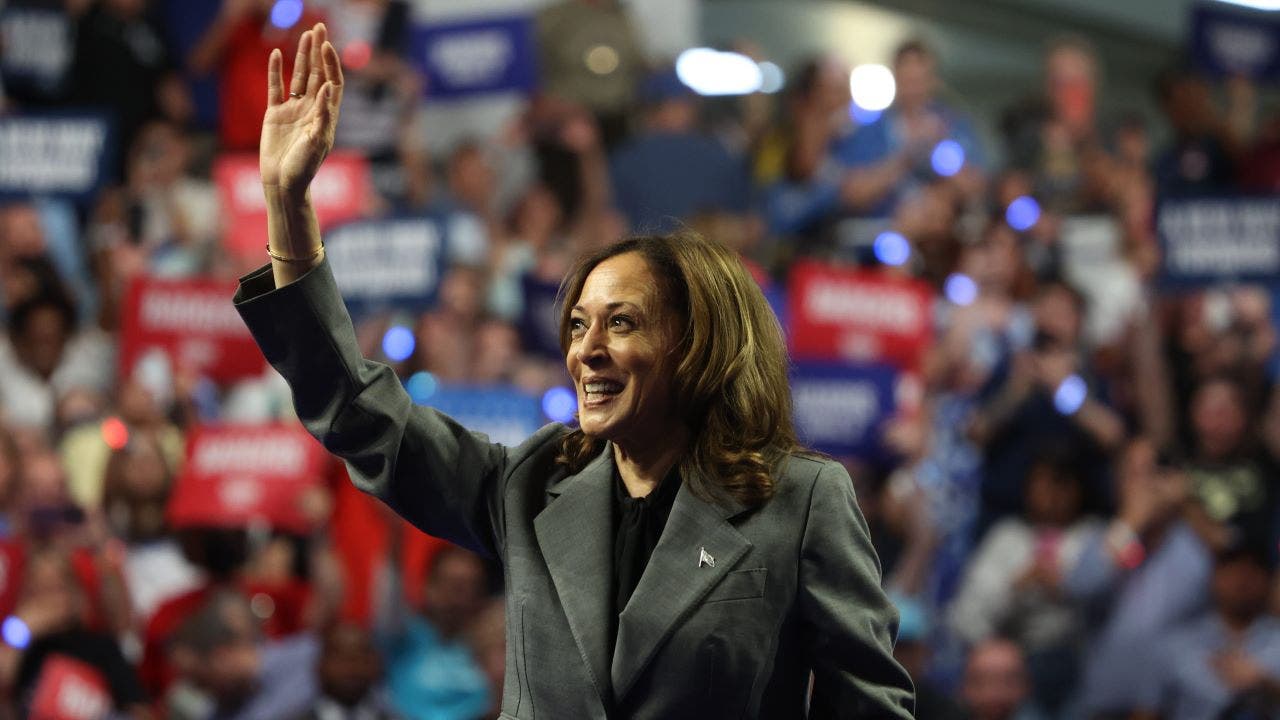
 Politics1 week ago
Politics1 week agoNew poll indicates whether Harris or Trump is making gains with younger voters
-

 News1 week ago
News1 week agoElection 2024 Polls: Texas
-

 News1 week ago
News1 week agoVideo: Where Trump and Harris Stand on Democracy
-

 World1 week ago
World1 week agoPhotos: The aftermath of a deadly Israeli attack on southern Beirut
-
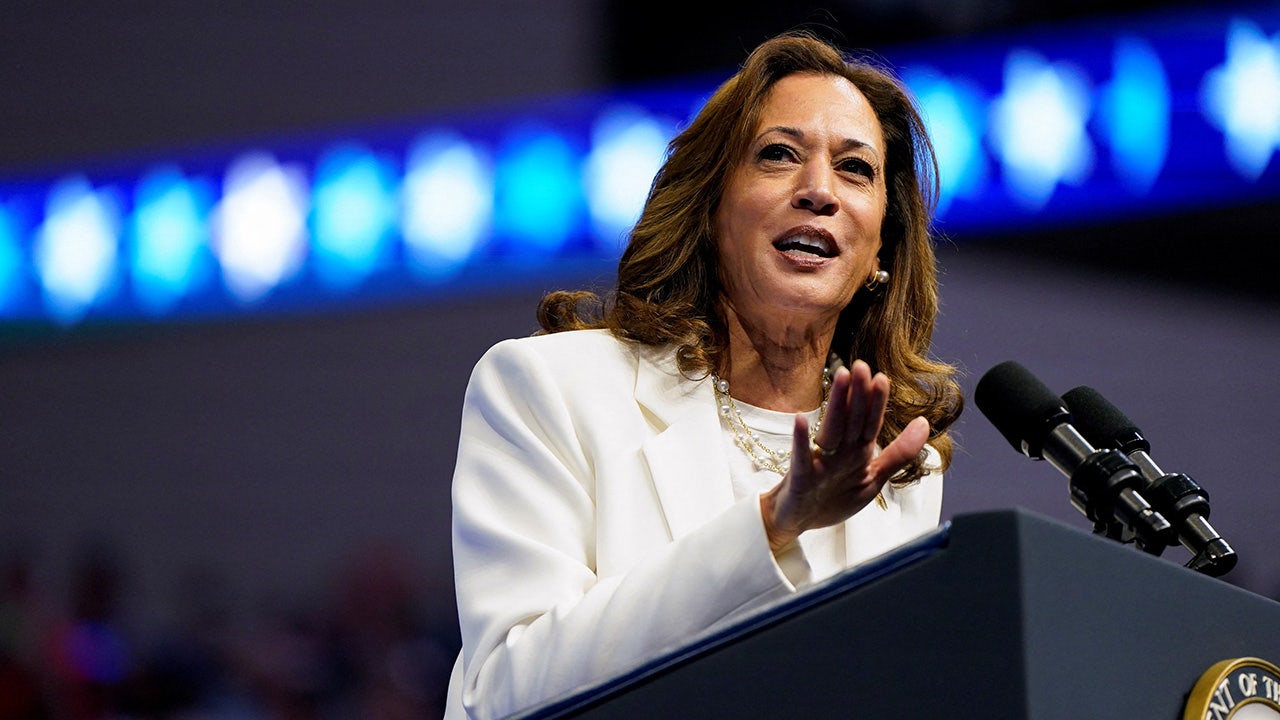
 Politics1 week ago
Politics1 week agoHarris calls for eliminating filibuster to pass 'Roe' abortion bill into federal law
-

 News1 week ago
News1 week agoRetired NFL Hall of Fame quarterback Brett Favre reveals he has Parkinson's disease
-

 Business1 week ago
Business1 week agoVideo: The U.S. Is Mining for Uranium
-
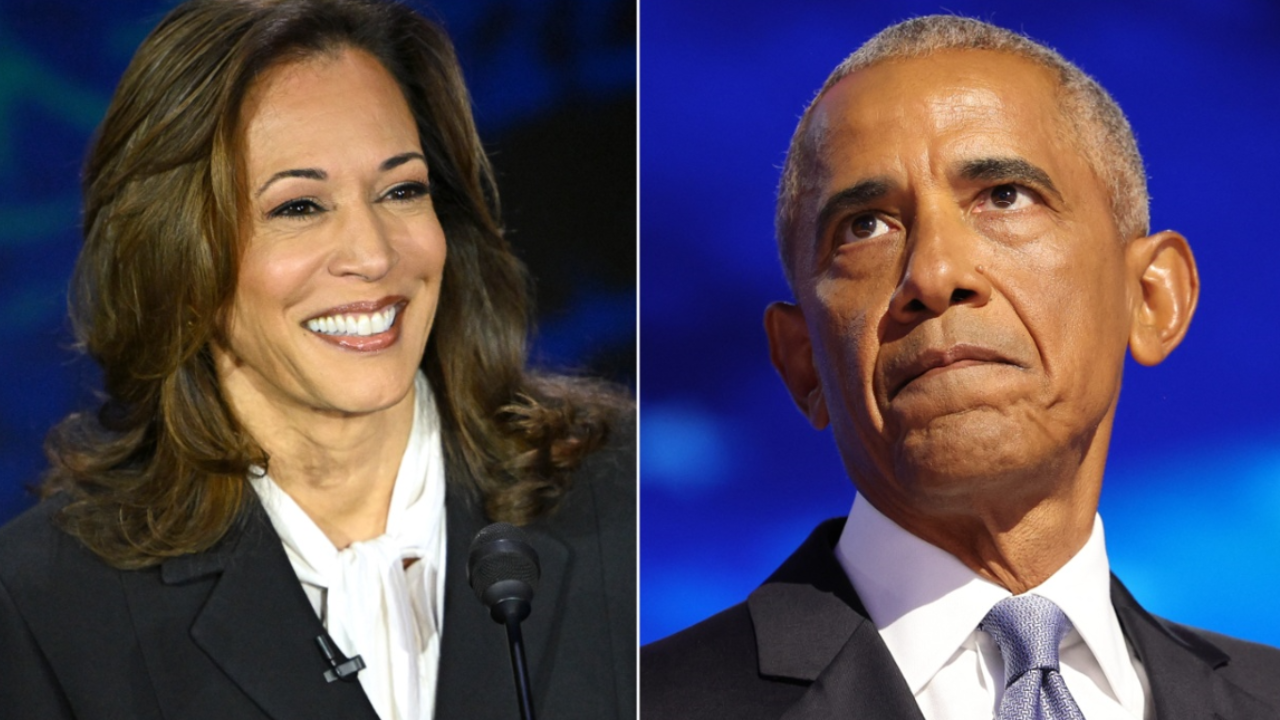
 Politics1 week ago
Politics1 week agoFLASHBACK: VP Harris pushed for illegal immigrant to practice law in California over Obama admin's objections
